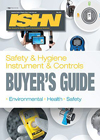
According to the OSHA Technical Manual, which prescribes workloads for workers under temperatures typically experienced outdoors during the summer months, to keep from exceeding the Threshold Limit Value (TLV) when the ambient temperature is above 86° F, the work regimen will consist of 25 percent work and 75 percent rest. This type of schedule plays havoc on productivity, as does the lost time incurred when a worker succumbs to heat stress. Plus, as workers become fatigued by back-to-back days — where each day they approach their TLV — their quality of life diminishes. That affects productivity and causes a rise in sick days.
As the temperature rises above 90°F, the body’s various cooling mechanisms shut down, leaving only evaporation via perspiration to cool the body. The downside of perspiration is that the body draws almost 50 percent of the blood away from other vital functions and sends it to the skin to aid in cooling and to provide the water to create perspiration.
Among these vital functions: transporting nutrients and oxygen to the heart and brain.
If you decrease oxygen to the heart, the chance of a heart attack increases. Decreasing the oxygen flow to the brain results in a significant increase in errors, further affecting productivity and safety.
Misting fans, gel packs & wet towels
Through the years, water, salt tablets and shelters for shade were used to help avoid heat stress. Replacing water lost through perspiration will help with dehydration, but it takes 24 hours for the water to completely make its way through the body and replenish the loss, so rehydrating does little or nothing to help cool the body. Misting fans are effective, but one needs to be sitting directly in front of the fan to receive any benefit. The quest for more portability led to the development of the ice vest, although the vests were very heavy, the ice melted quickly and once it did, the vests tended to trap the body’s heat.To lengthen cooling time, “Phase Change Vests” were introduced. Phase change gel packs could refreeze very quickly, but were as heavy and uncomfortable to wear as the ice vests. People have also tried using buckets of ice water and towels, but the water is usually too cold to be comfortable and people tend to put the towels on their head and neck. Since the body’s thermostat is the hypothalamus gland — which is found in the center of the head — putting a cold towel on the head and neck shuts down the body’s cooling system. If you blow cold air onto the thermostat in your home, you cool the thermostat and it shuts off the cooling, even as the heat in the house continues to rise. This same thing happens when you put a cold towel on your head and neck. The hypothalamus gland shuts down the cooling mechanisms while your core continues to heat up.
Cooling stations with aggressive cooling apparatus will help extend a worker’s productive time in a high heat environment. We experience this effect when we go from an air-conditioned building and climb into a closed car that has been sitting in the summer sun for several hours. Since the body’s core temperature has been lowered by a few degrees, we can tolerate sitting in a 125°F car for several minutes before we start to perspire and become uncomfortable.
Solutions to reduce recovery time
Special modified apparel on the market today can be used as a portable cooling station and is effective in cooling the body. Ice-chilled water is circulated from a cooler through tubing sewn to a shirt or a vest and then back to the cooler for re-cooling. Pre-cooling with 40°- 45°F water flowing through the tubing on the garment for 10 to 20 minutes at a cooling station will allow the worker to go for about 15 to 20 minutes beyond the time that they would normally spend in a hot environment before they start to become affected by the heat. The workers can then return to the cooling station following the completion of the job or as their core temperature begins to rise past their TLV. These systems significantly reduce the worker’s recovery time, due to the pre-cooling and post-job cooling. Their core temperature is back to normal in about 10 minutes.To further increase the worker’s mobility, waist packs and backpack systems use battery-powered pumps and bladders for ice and water storage. These units will last 45 minutes to an hour and one and a half to two hours, respectively, before the ice needs to be recharged.
By carefully monitoring your workers during the upcoming hot months and keeping their core temperatures down, you can maintain the productivity levels achieved during the cooler months, while reducing errors and sick days. When you help your workers avoid heat stress, you not only improve their quality of life, you may also discover a reduction in employee turnover — and the additional costs associated with that.


